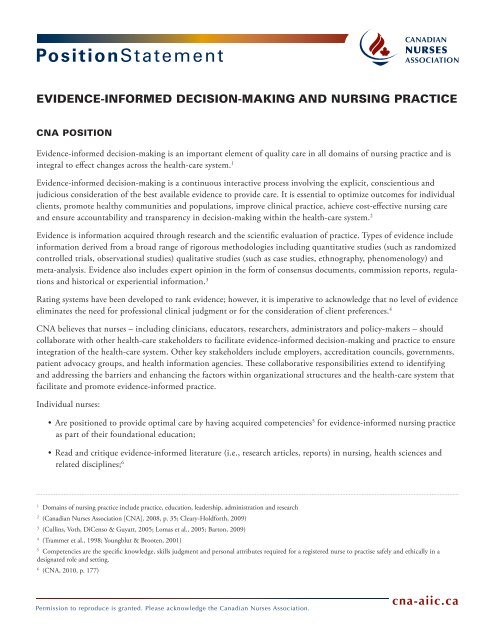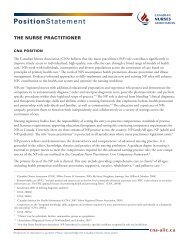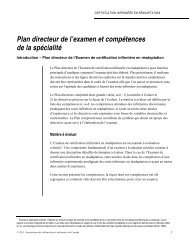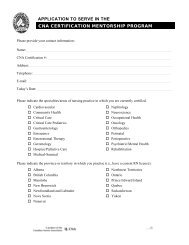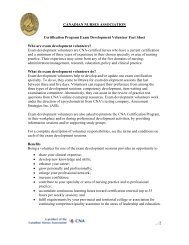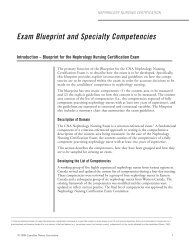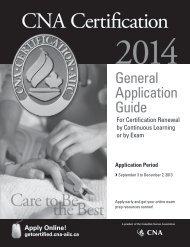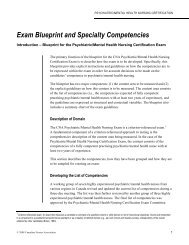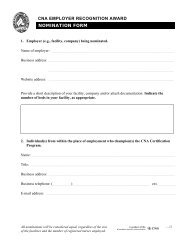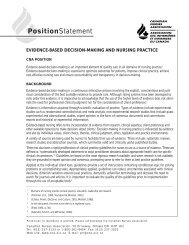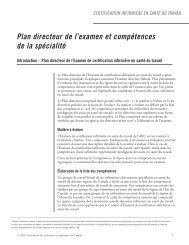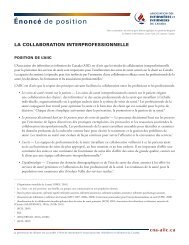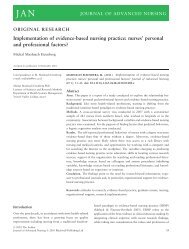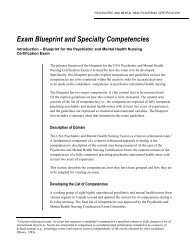evidence-informed decision-making and nursing practice
evidence-informed decision-making and nursing practice
evidence-informed decision-making and nursing practice
Create successful ePaper yourself
Turn your PDF publications into a flip-book with our unique Google optimized e-Paper software.
EVIDENCE-INFORMED DECISION-MAKING AND NURSING PRACTICE<br />
CNA POSITION<br />
Evidence-<strong>informed</strong> <strong>decision</strong>-<strong>making</strong> is an important element of quality care in all domains of <strong>nursing</strong> <strong>practice</strong> <strong>and</strong> is<br />
integral to effect changes across the health-care system. 1<br />
Evidence-<strong>informed</strong> <strong>decision</strong>-<strong>making</strong> is a continuous interactive process involving the explicit, conscientious <strong>and</strong><br />
judicious consideration of the best available <strong>evidence</strong> to provide care. It is essential to optimize outcomes for individual<br />
clients, promote healthy communities <strong>and</strong> populations, improve clinical <strong>practice</strong>, achieve cost-effective <strong>nursing</strong> care<br />
<strong>and</strong> ensure accountability <strong>and</strong> transparency in <strong>decision</strong>-<strong>making</strong> within the health-care system. 2<br />
Evidence is information acquired through research <strong>and</strong> the scientific evaluation of <strong>practice</strong>. Types of <strong>evidence</strong> include<br />
information derived from a broad range of rigorous methodologies including quantitative studies (such as r<strong>and</strong>omized<br />
controlled trials, observational studies) qualitative studies (such as case studies, ethnography, phenomenology) <strong>and</strong><br />
meta-analysis. Evidence also includes expert opinion in the form of consensus documents, commission reports, regulations<br />
<strong>and</strong> historical or experiential information. 3<br />
Rating systems have been developed to rank <strong>evidence</strong>; however, it is imperative to acknowledge that no level of <strong>evidence</strong><br />
eliminates the need for professional clinical judgment or for the consideration of client preferences. 4<br />
CNA believes that nurses – including clinicians, educators, researchers, administrators <strong>and</strong> policy-makers – should<br />
collaborate with other health-care stakeholders to facilitate <strong>evidence</strong>-<strong>informed</strong> <strong>decision</strong>-<strong>making</strong> <strong>and</strong> <strong>practice</strong> to ensure<br />
integration of the health-care system. Other key stakeholders include employers, accreditation councils, governments,<br />
patient advocacy groups, <strong>and</strong> health information agencies. These collaborative responsibilities extend to identifying<br />
<strong>and</strong> addressing the barriers <strong>and</strong> enhancing the factors within organizational structures <strong>and</strong> the health-care system that<br />
facilitate <strong>and</strong> promote <strong>evidence</strong>-<strong>informed</strong> <strong>practice</strong>.<br />
Individual nurses:<br />
• Are positioned to provide optimal care by having acquired competencies 5 for <strong>evidence</strong>-<strong>informed</strong> <strong>nursing</strong> <strong>practice</strong><br />
as part of their foundational education;<br />
• Read <strong>and</strong> critique <strong>evidence</strong>-<strong>informed</strong> literature (i.e., research articles, reports) in <strong>nursing</strong>, health sciences <strong>and</strong><br />
related disciplines; 6<br />
1<br />
Domains of <strong>nursing</strong> <strong>practice</strong> include <strong>practice</strong>, education, leadership, administration <strong>and</strong> research<br />
2<br />
(Canadian Nurses Association [CNA], 2008, p. 35; Cleary-Holdforth, 2009)<br />
3<br />
(Cullins, Voth, DiCenso & Guyatt, 2005; Lomas et al., 2005; Barton, 2009)<br />
4<br />
(Trammer et al., 1998; Youngblut & Brooten, 2001)<br />
5<br />
Competencies are the specific knowledge, skills judgment <strong>and</strong> personal attributes required for a registered nurse to practise safely <strong>and</strong> ethically in a<br />
designated role <strong>and</strong> setting.<br />
6<br />
(CNA, 2010, p. 177)
• Generate researchable questions <strong>and</strong> communicate them to their manager or clinical nurse leaders or associated<br />
researchers;<br />
• Participate in or conduct research; 7 <strong>and</strong><br />
• Evaluate <strong>and</strong> promote <strong>evidence</strong>-<strong>informed</strong> <strong>nursing</strong> <strong>practice</strong>.<br />
Professional <strong>and</strong> <strong>nursing</strong> specialty associations:<br />
• Use the best available <strong>evidence</strong> as a basis for st<strong>and</strong>ards <strong>and</strong> guidelines;<br />
• Lobby governments for funding to support <strong>nursing</strong> research <strong>and</strong> health information systems that include <strong>nursing</strong><br />
care data; <strong>and</strong><br />
• Lobby governments for healthy public policy, regulation <strong>and</strong> legislation that are <strong>evidence</strong>-<strong>informed</strong>.<br />
Nursing regulatory authorities:<br />
• Use the best available <strong>evidence</strong> as a basis for st<strong>and</strong>ards, guidelines <strong>and</strong> regulatory <strong>practice</strong>s; <strong>and</strong><br />
• Support nurses to meet competencies for <strong>evidence</strong>-<strong>informed</strong> <strong>practice</strong>.<br />
Researchers:<br />
• Identify knowledge gaps <strong>and</strong> establish research priorities in conjunction with clinicians <strong>and</strong>/or other health<br />
professionals, key stakeholders <strong>and</strong> client groups;<br />
• Generate high-quality <strong>evidence</strong> through research;<br />
• Facilitate capacity building of new nurse researchers; <strong>and</strong><br />
• Engage in effective knowledge transfer, translation <strong>and</strong> exchange to communicate relevant findings of the results<br />
of research to those who require the information.<br />
Educators <strong>and</strong> educational institutions:<br />
• Support those graduating from basic <strong>and</strong> continuing <strong>nursing</strong> education programs to acquire competencies to<br />
provide <strong>evidence</strong>-<strong>informed</strong> <strong>nursing</strong>;<br />
• Use <strong>and</strong> develop <strong>evidence</strong>-<strong>informed</strong> curricula by providing high-quality education in research methods, <strong>evidence</strong><br />
collection <strong>and</strong> analysis; <strong>and</strong><br />
• Promote a spirit of inquiry, critical thinking, openness to change <strong>and</strong> a philosophy of life-long learning.<br />
7<br />
(Edwards et al., 2009)<br />
page 2 of 5
Health service delivery organizations:<br />
• Reduce barriers against <strong>and</strong> enhance the factors within organizations that promote <strong>evidence</strong>-<strong>informed</strong> <strong>practice</strong> by<br />
integrating research findings <strong>and</strong> <strong>practice</strong> guidelines;<br />
• Evaluate outcome measures through ongoing audits <strong>and</strong> formal research studies;<br />
• Support registered nurses’ involvement in research <strong>and</strong> in the transfer of research into organizational policy <strong>and</strong><br />
<strong>practice</strong>; <strong>and</strong><br />
• Provide continuing education to assist nurses to maintain <strong>and</strong> increase their competence with respect to<br />
<strong>evidence</strong>-<strong>informed</strong> <strong>practice</strong>.<br />
Governments:<br />
• Support development of health information systems that support <strong>evidence</strong>-<strong>informed</strong> <strong>nursing</strong> <strong>practice</strong>;<br />
• Support health information institutions; <strong>and</strong><br />
• Provide adequate funding to support <strong>nursing</strong> research in all its phases.<br />
National <strong>and</strong> provincial or territorial health information institutions:<br />
• Collect, store, maintain, update <strong>and</strong> retrieve health data in health information systems accessible to <strong>nursing</strong><br />
<strong>and</strong> health researchers;<br />
• Provide comprehensive, integrated <strong>and</strong> relational systems that include <strong>nursing</strong> data <strong>and</strong> health outcomes; <strong>and</strong><br />
• Collect data using st<strong>and</strong>ardized languages to ensure that <strong>nursing</strong> data can be aggregated <strong>and</strong> compared across<br />
<strong>and</strong> between sites.<br />
BACKGROUND<br />
The distinction between the terms “<strong>evidence</strong>-based” <strong>and</strong> “<strong>evidence</strong>-<strong>informed</strong>” is important. The concept of <strong>evidence</strong><strong>informed</strong><br />
<strong>decision</strong>-<strong>making</strong> builds on <strong>evidence</strong>-based health care. It acknowledges the many factors beyond <strong>evidence</strong> –<br />
for example, available resources or cultural <strong>and</strong> religious norms – that influence <strong>decision</strong>-<strong>making</strong>. 8<br />
Evidence-<strong>informed</strong> <strong>nursing</strong> is the ongoing process that incorporates <strong>evidence</strong> from research, clinical expertise, client<br />
preferences <strong>and</strong> other available resources to make <strong>nursing</strong> <strong>decision</strong>s about clients. 9 Decision-<strong>making</strong> in <strong>nursing</strong> <strong>practice</strong><br />
is influenced by <strong>evidence</strong> <strong>and</strong> also by individual values, client choice, theories, clinical judgment, ethics, legislation,<br />
regulation, health-care resources <strong>and</strong> <strong>practice</strong> environments. 10 At the community level, <strong>evidence</strong>-<strong>informed</strong> public health<br />
is defined as “the process of integrating science-based interventions with community preferences to improve the health<br />
of populations.” 11<br />
8<br />
(Ciliska, Thomas & Buffet, 2008, p.7.)<br />
9<br />
(Ciliska, Pinelli, DeCenso & Cullum, 2001; Scott, McSherry, 2008).<br />
10<br />
(Dicenso, Ciliska & Guyatt, 2005)<br />
11<br />
(Kohatsu, Robinson & Torner, 2004, p. 419)<br />
page 3 of 5
A variety of sources are being used by nurses to facilitate their use of <strong>evidence</strong>. These sources include systematic<br />
reviews, research studies <strong>and</strong> abstraction journals that summarize valid <strong>and</strong> clinically useful published studies.<br />
There has also been a rapid proliferation of clinical <strong>practice</strong> guidelines for nurses to use as a source of <strong>evidence</strong>. These<br />
are defined as “systematically developed statements to assist practitioner <strong>decision</strong>s about appropriate health care for<br />
specific clinical circumstances.” 12 Guidelines are based on the most rigorous research available, <strong>and</strong> when research is<br />
not available, they are grounded in expert opinion <strong>and</strong> consensus. 13<br />
Applied at the individual client level, guidelines provide a set of instructions containing conditional logic for solving<br />
problems or accomplishing tasks. Appropriately applied, guidelines can reduce uncertainties associated with clinical<br />
<strong>decision</strong>s, diminish variation around usual <strong>practice</strong>s, demystify unfamiliar terminology <strong>and</strong> decrease the need to search<br />
for journals <strong>and</strong> articles. It is important to evaluate the quality of the guidelines prior to implementation through the<br />
use of acceptable tools. 14<br />
Approved by the CNA Board of Directors<br />
October 2010<br />
References:<br />
Canadian Nurses Association. (2008). Code of ethics for registered nurses. Ottawa: Author.<br />
Canadian Nurses Association. (2010). The Canadian registered nurse examination prep guide. Ottawa: Author.<br />
Barton, A. (2009). Knowledge management <strong>and</strong> the clinical nurse specialist. Clinical Nurse Specialist, 23(3), 123-124.<br />
Ciliska, D., Pinelli, J., DeCenso, A., & Cullum, N. (2001). Resources to enhance <strong>evidence</strong>-based <strong>nursing</strong> <strong>practice</strong>.<br />
AACN Clinical Issues, 12(4), 520-528.<br />
Ciliska, C., Thomas, H., Buffet, C. (2008). An introduction to <strong>evidence</strong>-<strong>informed</strong> public health <strong>and</strong> a compendium of<br />
critical appraisal tools for public health <strong>practice</strong>. Retrieved from http://www.nccmt.ca/pubs/eiph_backgrounder.pdf<br />
Cleary-Holdforth, L. T. (2009). Evidence-based <strong>practice</strong>: Improving patient outcomes. Nursing St<strong>and</strong>ard, 23(32), 35-39.<br />
Cullins, S., Voth, T., DiCenso, A., & Guyatt, G. (2005). Finding the <strong>evidence</strong>. In A. Dicenso, G. Guyatt, & D. K.<br />
Ciliska (Eds.), Evidence-based <strong>nursing</strong>: A guide to clinical <strong>practice</strong>. (pp. 20-43). St. Louis, MO: Elsevier/Mosby.<br />
Dicenso, A., Ciliska, D. K., & Guyatt, G. (2005). Introduction to <strong>evidence</strong>-based <strong>nursing</strong>. In A. Dicenso, G. Guyatt,<br />
& D. K. Ciliska (Eds.), Evidence-based <strong>nursing</strong>: A guide to clinical <strong>practice</strong>. (pp. 3-19). St. Louis, MO: Elsevier/Mosby.<br />
Edwards, N., Webber, J., Mill, J., Kahwa, Roelofs, S. (2009). Building capacity for nurse-led research. International<br />
Nursing Review, 56(1), 88-94.<br />
12<br />
(Field, 1995, p. 38)<br />
13<br />
(Schunemann, Fretheim & Oxman, 2006)<br />
14<br />
(Glanville, Schrim & Wineman, 2000)<br />
page 4 of 5
Field, M. (Ed.). (1995). Committee on methods for setting priorities for guidelines development. Washington: Institute<br />
of Medicine.<br />
Glanville, I., Schrim, V., & Wineman, N. (2000). Using <strong>evidence</strong>-based <strong>practice</strong> for managing clinical outcomes in<br />
advanced <strong>practice</strong> <strong>nursing</strong>. Journal of Nursing Care Quality, 15(1), 1-11.<br />
Kohatsu, N. D., Robinson, J. G., & Torner, J. C. (2004). Evidence-based public health: An evolving concept. American<br />
Journal of Preventive Medicine, 27(5), 417-421.<br />
Lomas, J., Culyer, T., McCutcheon, C., McAuley, L., & Law, S. (2005). Final report: Conceptualizing <strong>and</strong> combining<br />
<strong>evidence</strong> for health system guidance. Ottawa: Canadian Health Services Research Foundation.<br />
Schunemann, H. J., Fretheim, A., Oxman, A. D. (2006). Improving the use of research <strong>evidence</strong> in guideline development.<br />
Health Research Policy <strong>and</strong> Systems, 4(14). Retrieved from http://www.health-policy-systems.com/content/4/1/14<br />
Scott, K., & McSherry, R. (2008) Evidence-based <strong>nursing</strong>: Clarifying the concepts for nurses in <strong>practice</strong>. Journal of<br />
Clinical Nursing, 18(8), 1085-1095.<br />
Trammer, J., Squires, S., Brazil, K., Gerlach, J., Johnson, J., Muisiner, D., et al. (1998). Factors that influence<br />
<strong>evidence</strong>-based <strong>decision</strong>-<strong>making</strong>. Canadian Health Action: Building on the Legacy: vol. 5. Making <strong>decision</strong>s: Evidence<br />
<strong>and</strong> information. Sainte-Foy, Quebec: Multimondes <strong>and</strong> the National Forum on Health.<br />
Youngblut, J. <strong>and</strong> Bronte, D. (2001). Evidence-based <strong>nursing</strong> <strong>practice</strong>: Why is it important AACN Clinical Issues,<br />
12(4), 468-476.<br />
Also see:<br />
CNA position statement: Nursing Leadership (2009)<br />
International Council of Nurses position statement: Nursing Research (2007)<br />
Replaces:<br />
Evidence-based Decision-<strong>making</strong> <strong>and</strong> Nursing Practice (2002)<br />
PS-113<br />
page 5 of 5


